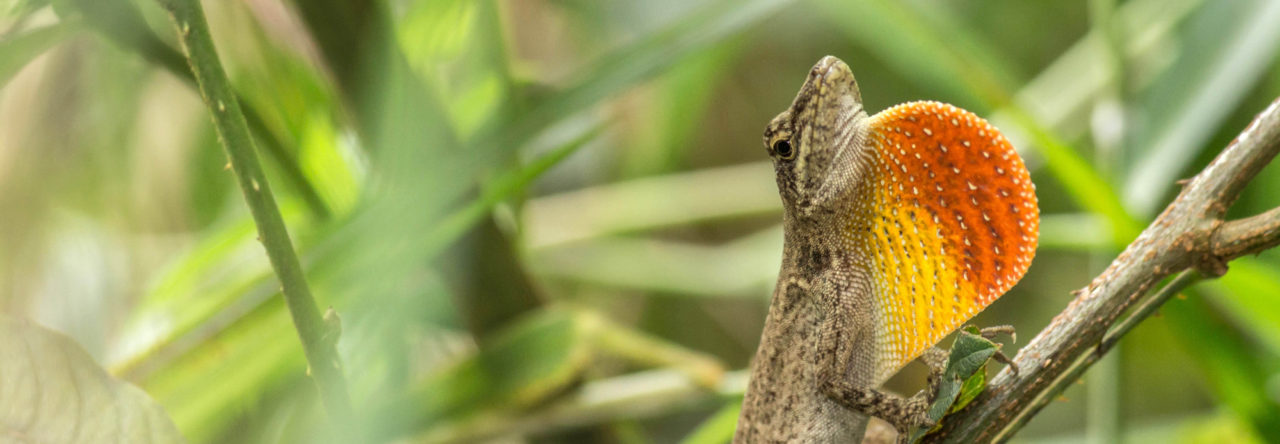The picture above comes from a post on Jacqui Thurlow-Lippisch’s blog, about an epic battle in Sewall, Florida. Jacqui kindly put me in touch with the photographer, Nina Barcik, who provided some more information:
- The two bricks beneath the snake are: 4½”x 6″ and 6″x 9½” to give you some reference for size.
- One hour and 20 minutes after the picture was taken, the lizard was completely consumed and the snake was on it’s back with the head and first 6″ leaning vertically against the side of the planter.
30 minutes later the snake was gone.
By the way, who prefers the name corn snake to red rat snake?
Here’s another shot:
Latest posts by Jonathan Losos (see all)
- Evolution in Real Time on Lizard Island - March 23, 2025
- Spider Snags Adult Anolis osa - March 22, 2025
- An Homage to the Green Anoles of New Orleans - March 21, 2025




John Sullivan
It’s hard to root against an anole, but in this case I’m glad the native species won.
John
George Gorman
This person indicates an irrational fear of immigrants. Florida’s diversity is enhanced by the influx of residents from Caribbean islands. And Corn Snakes (NOT “rat snakes” ugh) have a much greater opportunity for new kinds of cuisine. A WIN-WIN.
But maybe now that our President wants to hire thousands of new ICE agents, he should equip them with nooses and have them remove those pesky non-native anoles. Maybe deport 12 million A. sagrei back to Cuba , and see how that impacts perch height in carolinensis. This would create employment, further scientific knowldge, and take the heat off of millions of law-abiding, tax-paying human residents.
Michael Shiver
Corn snakes are rat snakes …though they are not in the same group as Obsoleta…yellow ..black ..Everglades …They still are a rat snake …Pantherophis guttatus is their Latin name..
George Gorman
Sorry….my comment was purely in jest. I had no intent to separate red rat snakes from their black and yellow brethren. Going forward, I will stay away from comedic attempts on these pages. Clearly not my strong suit.
Scott Boback
Here is another red rat snake taking an invasive brown anole. Photo taken near Homestead FL last January.
Jonathan Losos
And another attacked anole biting its snake attacker on the nose (just like here). I presume it wasn’t a happy outcome for the anole?
Scott Boback
Hi Jonathan,
Sorry for my tardy response, I had to survey the rest of our crew to try and confirm some info. We were part of a larger group that night that was surveying for Oustalet’s chameleons. Because of this we were unable to stick around too long and observe the interaction. But we did not see the snake swallow the lizard. What Im not remembering is whether the snake killed the anole via constriction.
Jacqui Thurlow-Lippisch
What a shot!
Jacqui Thurlow-Lippisch
Looking closer that looks like a regular anole not a Knight Anole….? 🙂
Mike
It’s a Knight Anole, the native Carolina Anole is much smaller with a smoother head
Jacqui Thurlow-Lippisch
Thank you for clarifying.
Scott Boback
Hi Jacqui,
You are correct it was not a Knight anole. This was a Brown anole (N. sagrei).
Jacqui Thurlow-Lippisch
Thank you. I got lucky.
James Stroud
I have seen brown anoles (A. sagrei) being depredated by black racers (Coluber constrictor) down here in south Florida. Nearly every time the lizard will reciprocally bite the snake. No pictures unfortunately.
Never seen any snakes eating knight anoles yet though!
Scott Boback
Hi James,
Were the racers constricting the anoles?
James Stroud
Hey Scott, they can constrict, however from the opportunities I have witnessed it often looks more like they are manipulating the anole to get it into a good position for ingestion. They eat very fast after the initial strike.
Say hi to Ed from me next time you’re out look for Oustalet’s. I’ll come back out one of these days.
Jacqui Thurlow-Lippisch
Thank you. I got lucky.
Jacqui Thurlow-Lippisch
Dear Dr Losos, I am posting 3 photos of a Knight Anole that was injured that we found in my tree in 2011. We kept it, fixed up his eye and then released it. It fell during a freeze onto our metal roof injuring its eye very badly.
Jacqui Thurlow-Lippisch
Another shot.
Jacqui Thurlow-Lippisch
Regarding first 3 photos: I can’t quite remember why one photo shows the lizard molting and then in a later photo the skin is gone….? Maybe it came off. But the lizard looks like it is not molting in the first photo when its damaged eye and face was evident…? Nonetheless, my camera date “says” it is the same lizard.
Jonathan Losos
Wow. Kudos to you for patching him up. He didn’t look very good. I suspect you’re right that the skin came off between pictures. In the last shot, he clearly was about to get out of his skin. They often pull it off and eat it.
Jacqui Thurlow-Lippisch
They eat it? Wow. Cool.
Jacqui Thurlow-Lippisch
Photo when brown in color.
Jacqui Thurlow-Lippisch
Different lizard. This is the tree they live on-a strangler fig.
Jacqui Thurlow-Lippisch
Same lizard, #2, as in above photo. 2005.
Jonathan Losos
What a great animal. Beautiful.